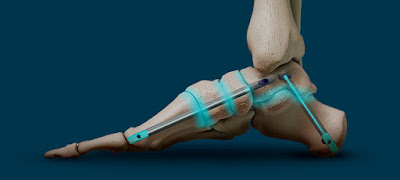If you have diabetes, you already know the complications it can cause for foot health. If you notice that your foot feels warm to the touch, or looks red and swollen, it could signal that you have this condition. However, the same symptoms apply to numerous other foot injuries.
Learn
how to spot the symptoms of diabetic Charcot foot, also called Charcot
arthropathy. Additionally, we’ll discuss the causes and treatment options,
including the DynaNail
TTC Fusion System® by DJO®.
Causes of Charcot Foot
So, besides diabetes, what else causes Charcot foot? This condition affects those who can't feel due to nerve damage in their feet. Although there is no singular cause, the following conditions may trigger diabetic Charcot arthropathy:
- Infection
- Alcohol or drug abuse
- Undetected sprain or break
- Organ rejection
- Spinal cord disease
- Parkinson’s disease
- Syphilis
- HIV
Symptoms of Charcot Arthropathy
As the condition progresses, your bones weaken and may shift or break. As a result, the symptoms of more advanced Charcot arthropathy include:
- Loss of foot shape. The arch of your foot falls until the bones are lower than your toes or heels, a condition known as “rocker bottom” foot.
- Curled toes
- Twisted, unsteady ankle
- Bones press on shoes, causing wounds and infections
Although diabetes isn't the only cause
of Charcot arthropathy, diabetics often have poor blood flow. That makes it
difficult for the foot to heal and often results in amputation.
Treatment for Diabetic Charcot Foot
If you have early stage Charcot arthropathy, your
doctor may prescribe a cast or boot to keep the bones in place and to promote
healing. Nonsurgical treatment may also include special shoes to promote
healing and protect the bones.
Unfortunately, diabetics and some others who develop
this condition have nerve damage (neuropathy) that prevents them from feeling
sprains, fractures, and breaks. This may lead to more damage, calling for
stronger treatment methods.
The surgical approach will depend on the nature of the deformity, as follows:
- Mild deformity with tight tendons at the heel. Surgery to lengthen the Achilles tendon can relieve pressure on the heel at midfoot. This promotes the healing of ulcers.
- Protrusions on the bottom of the feet. This is more severe than a mild deformity. The type of surgery depends on the stability of your foot:
o
For a
stable deformity, the surgeon can shave off the protruding bone.
o
For an
unstable deformity, the surgeon may need to fuse and reposition the bones to
promote healing.
DJO’s DynaNail Treatment Saves Limbs
DJO has developed the DynaNail treatment system to
save limbs and save lives. Whether you are a surgeon who treats diabetic Charcot foot or someone who lives with the condition, you need
to know about this effective surgical option.
DJO’s
motto is “get and keep people moving.” If you have diabetic Charcot foot or
treat patients who do, we want to help. Let us know if you have questions about
how our foot products
can help heal Charcot arthropathy. Contact us today
for more information.





No comments:
Post a Comment